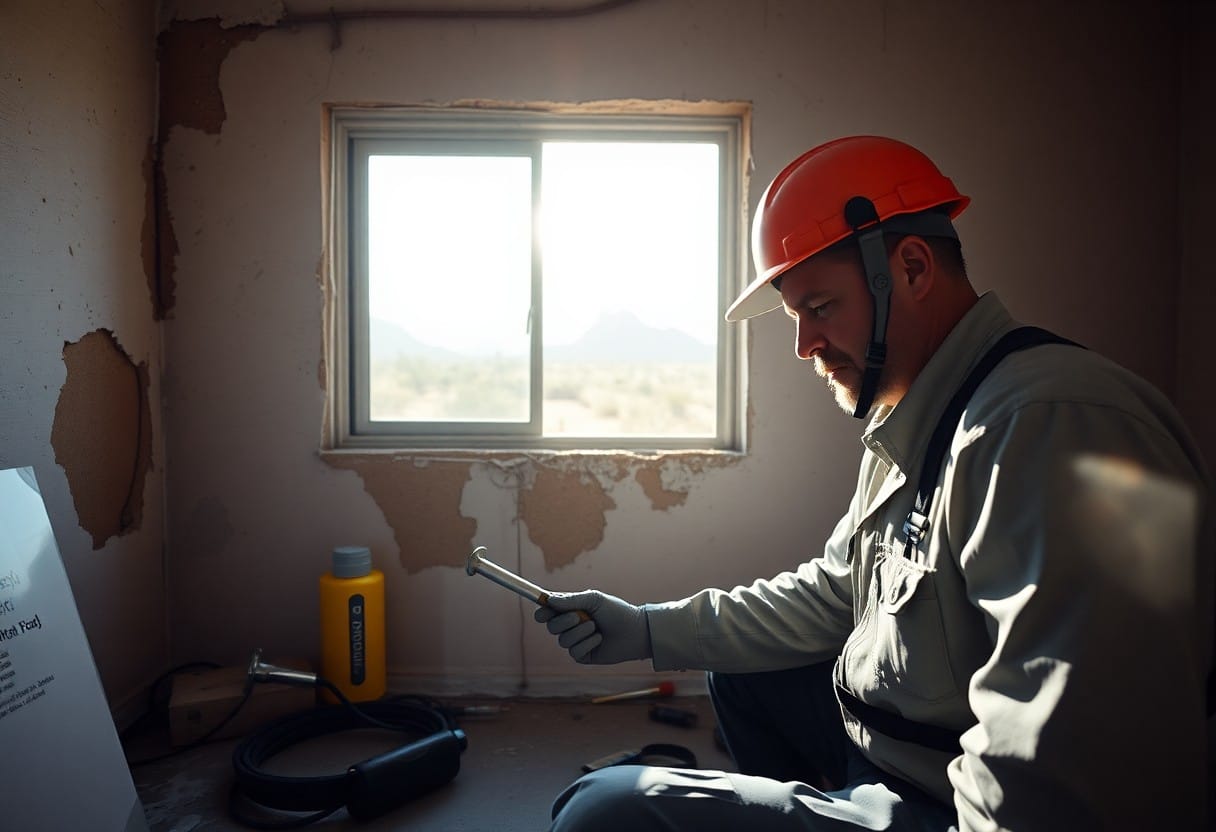HVAC systems can lead to significant water damage if leaks occur, which can result in costly repairs and health hazards from mold growth. Understanding how to identify these leaks and taking immediate action is necessary to protecting your home. In this guide, you’ll learn about effective emergency repair tactics and preventive measures specifically tailored for the unique climate challenges in Phoenix, ensuring your HVAC system operates smoothly without jeopardizing your property.

Understanding HVAC Systems
HVAC systems are intricate networks designed to manage heating, ventilation, and air conditioning within buildings. Understanding their structure is vital for preventing and addressing issues, especially in climates like Phoenix, where temperature fluctuations can strain these systems. Systems typically comprise four primary components: the furnace, air conditioner, ductwork, and thermostat. Each part plays a unique role, with the furnace or air conditioner generating conditioned air, the ductwork distributing this air throughout your home, and the thermostat regulating the temperature based on your preferences.
Components of HVAC Systems
Your HVAC system’s effectiveness relies on the seamless operation of its individual components. The furnace heats the air using either gas, electricity, or oil and distributes it through the ductwork. An air conditioner, on the other hand, cools the air via a refrigerant, which absorbs heat from inside and releases it outside. The thermostat acts as your central control panel, enabling you to set your desired temperature and initiating the cycle of heating or cooling. Maintaining each of these components can prevent costly repairs and water damage in the long run.
Common Causes of HVAC Leaks
Several factors contribute to HVAC leaks, often leading to water damage in your home. Poor maintenance practices can result in clogged drain lines, which are responsible for removing condensation produced during the cooling process. Aging equipment, particularly in units that are over ten years old, may develop rust or wear, further increasing the likelihood of leaks. Additionally, improper installation or connections can exacerbate these issues, leading to significant water accumulation in your living space.
Areas where leaks commonly originate include the condensate drain line, evaporator coil, and even the air handler itself. If your system is located in a less accessible space, like an attic or crawl space, leaks can go unnoticed for extended periods, amplifying the damage. Regular inspections and maintenance of your HVAC system can help you identify and address these potential issues before they escalate.
Identifying Water Damage
Signs of Water Damage in Homes
Stains and discoloration on ceilings and walls are often the first indicators of water damage. These could appear as brown spots or streaks, typically originating from areas near your HVAC system. Peeling paint or wallpaper may also signal moisture issues, indicating that your walls have absorbed excess water. In more severe cases, you might notice mold growth, which can pose health risks and points to an ongoing moisture problem.
Another sign is the presence of a musty odor, often linked to hidden water damage. Pay attention to warped flooring, particularly in areas adjacent to your HVAC units, which can indicate persistent moisture exposure. Additionally, higher-than-normal humidity levels in your home can hint at HVAC leaks, especially if your system is running continuously without adequate dehumidification.
Assessing the Extent of the Damage
To effectively assess water damage, begin by inspecting the areas most affected by your HVAC system. Use a moisture meter to gauge the humidity levels within walls and ceilings, as readings above 15% often signal significant damage. Look for any signs of structural instability, such as bowed walls or sagging ceilings, which may require immediate professional attention to ensure safety.
Examine the insulation around your HVAC ducts as well, as wet or compromised insulation can lead to further damage if not addressed. Conducting a thorough examination helps you determine whether a simple repair is sufficient or if extensive restoration efforts are necessary. Document the findings with photographs for insurance purposes, if applicable.
Emergency Repair Steps
Immediate Actions to Take
Upon discovering a leak from your HVAC system, your first step is to turn off the power to avoid any potential hazards. Locate your HVAC unit’s main power switch or the breaker in your electrical panel. Next, contain the water by placing buckets or towels under the leak to minimize damage to your floors and belongings. If possible, use a wet/dry vacuum to remove standing water promptly, which can help prevent mold growth and further damage within hours.
Inspect nearby areas for additional issues. If you notice any mold or water stains on walls or ceilings, document these with photographs for your insurance claim. Additionally, check your condensate drain pan for clogs, as this component is often the cause of leaks. If you observe blockage, clear it carefully to alleviate the issue and allow for proper drainage.
Hiring Professional Help
If the leak persists after your initial attempts to contain it, seeking professional assistance is wise. Licensed HVAC technicians possess the expertise needed to identify the source of the problem quickly. They will conduct a thorough inspection, ensuring that all potential leak points are examined, including ductwork, condensate lines, and connections. Professionals utilize specialized equipment such as moisture meters and thermal imaging to detect hidden water damage.
Investing in professional help not only addresses the immediate leak but also provides long-term solutions. Technicians can advise on necessary repairs and preventative maintenance, reducing the risk of future leaks. They often carry out comprehensive inspections, which can reveal underlying issues that might not be apparent initially. Engaging experts can save you from costly damages that could escalate if left unaddressed.
Long-term Solutions
Repairing and Replacing HVAC Units
Over time, you may find that repairing your HVAC system is no longer sufficient due to persistent leaks or inefficiency. If frequent repairs lead to increased downtime or costs, consider investing in a new unit. Modern HVAC systems are designed to be more energy-efficient and often come equipped with better moisture management systems, reducing the likelihood of leaks. Selecting a unit with a high SEER rating can help save on energy costs while providing optimal performance.
If you opt to replace your HVAC unit, ensure that the installation is performed by a certified professional. Proper installation is critical in preventing future water damage. Choose reputable brands that offer warranties and consider obtaining a maintenance plan to keep your system functioning at its best. Engaging a reliable service for consistent checks can minimize the risk of future complications and enhance the longevity of your new system.
Water Damage Restoration Options
After identifying and repairing the HVAC leak, addressing the water damage promptly is vital for preventing further deterioration. Water damage restoration generally involves several steps: drying out the affected area, removing damaged materials, and applying treatments to prevent mold growth. You might consider hiring a professional to evaluate the extent of the damage before moving forward with restoration. By opting for expert assistance, you increase the chances of a thorough and effective recovery, ensuring your space returns to its original condition.
There are various techniques available for water damage restoration, including dehumidification, thermal imaging, and mold remediation. Each method targets specific aspects of water damage while allowing for a customized approach based on the severity and type of damage experienced. Utilizing advanced technology not only improves the restoration process but also helps mitigate future risks.

Prevention Strategies
Regular Maintenance of HVAC Systems
Conducting regular maintenance of your HVAC system is vital in preventing leaks and minimizing the risk of water damage. Schedule a professional inspection at least twice a year to ensure that all components are functioning correctly. Regular maintenance includes cleaning coils, checking drain lines, and inspecting ductwork for any signs of wear or damage. Neglecting these tasks can lead to the buildup of debris, restricting water flow and causing leaks.
Additionally, a well-maintained system operates more efficiently, saving you money on energy bills. Keeping an eye on the condensate drain is crucial, as clogs can cause water to back up and spill over.
Homeowner Tips for Leak Prevention
As a homeowner, you can take specific steps to prevent leaks in your HVAC system. Begin by ensuring that your gutters and downspouts are clear, directing water away from your home’s foundation. Inspect the area around your HVAC unit for any signs of pooling water or poor drainage, which can exacerbate leak issues. Regularly check that your air filters are clean and replace them as necessary to maintain airflow.
Another effective strategy is to insulate ductwork that runs through unconditioned spaces. This prevents condensation that can lead to moisture buildup. If you notice any leaks, act quickly to repair them. Implementing these preventive measures can significantly reduce the likelihood of water damage from HVAC leaks. The following points summarize key homeowner tips:
- Clear your gutters and downspouts.
- Inspect around the HVAC for pooling water.
- Regularly check and replace air filters.
- Insulate ductwork in unconditioned spaces.
- Act promptly on any leak repairs.
Learning about your HVAC system’s operation can help identify potential problems early on. Establishing a seasonal inspection routine allows you to detect and address issues before they escalate. The effort you put into maintaining your HVAC system contributes significantly to preventing leaks, protecting your property from undesirable water damage.
- Establish a seasonal inspection routine.
- Educate yourself about HVAC operation.
- Actively monitor for any irregularities.
- Stay informed about common hydronic leaks.
- Prioritize repairs on detected issues.
Insurance Considerations
Understanding Coverage for Water Damage
Your homeowners insurance policy typically covers water damage stemming from sudden and accidental leaks, including those caused by HVAC system failures. However, specific coverage for HVAC-related water damage may vary significantly between policies. Evaluating your policy’s terms and conditions is necessary to understand any exclusions or limitations on coverage for water damage. For instance, many policies do not cover damage resulting from a lack of maintenance or wear and tear, which could leave you vulnerable to substantial out-of-pocket expenses.
Water damage claims related to HVAC systems may also be influenced by factors such as the age of your HVAC unit and the history of maintenance records. Insurers often assess the potential for prior neglect or failure to address repair issues before approving a claim. Keeping detailed records of all maintenance and repairs performed on your HVAC system can strengthen your position when negotiating with your insurance provider.
Filing Claims for HVAC-Related Issues
Filing a claim for water damage from an HVAC leak requires prompt action and thorough documentation. Start by contacting your insurance company to notify them of the incident while keeping in mind any filing deadlines that may apply. Additionally, taking immediate steps to mitigate further damage, such as addressing the source of the leak and removing standing water, demonstrates your commitment to minimizing the impact of the loss.
It’s necessary to document the damage extensively. Take photographs of affected areas, gather invoices for emergency repairs, and compile a list of any personal property damaged by water. Detailed documentation not only aids the claim process but also can affect the total compensation you receive. Even minor damages can add up, reinforcing the need to keep meticulous records throughout the process.
Summing up
As a reminder, addressing water damage from HVAC leaks promptly is crucial for protecting your property in Phoenix. You must regularly inspect your HVAC system for signs of leaks and address any minor issues before they escalate into major problems. Implementing preventive measures, such as maintaining adequate drainage and ensuring proper airflow, can significantly reduce the risk of leaks.
Additionally, if you encounter water damage, seeking immediate emergency repair services will help mitigate further complications. You should also document any damage for your records and communication with your insurance company. By staying proactive in your maintenance and repair efforts, you can effectively safeguard your home and maintain a comfortable living environment.

